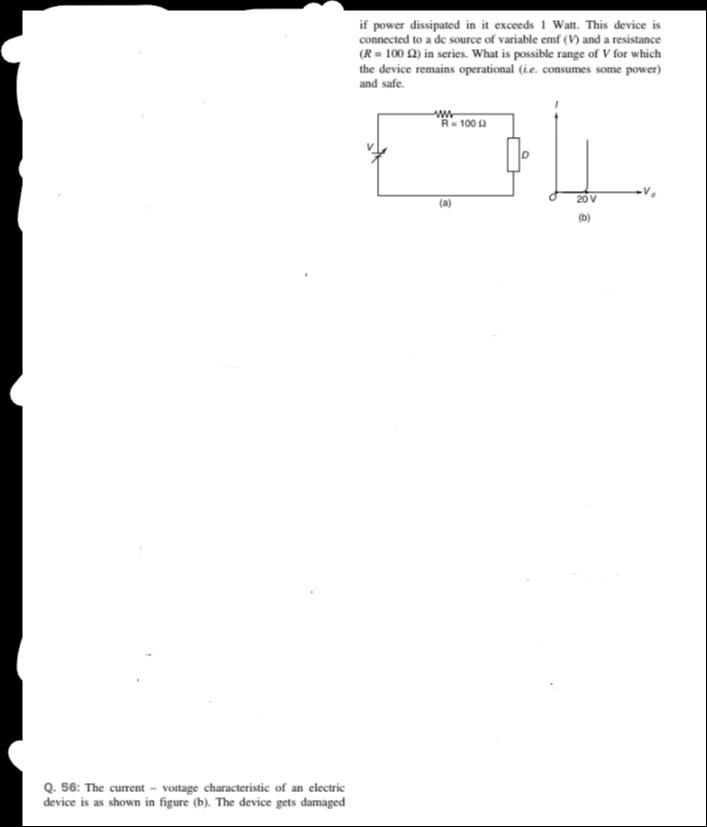Question
Question: The current - vortage characteristic of an electric device is as shown in figure (b). The device get...
The current - vortage characteristic of an electric device is as shown in figure (b). The device gets damaged if power dissipated in it exceeds 1 Watt. This device is connected to a dc source of variable emf (V) and a resistance (R=100Ω) in series. What is possible range of V for which the device remains operational (i.e. consumes some power) and safe.

20 V < V ≤ 25 V
Solution
The problem involves analyzing a series circuit containing a variable DC source, a resistor, and an electric device with given I-V characteristics. We need to find the range of the source voltage (V) for which the device is both operational (consumes some power) and safe (power dissipated does not exceed 1 Watt).
1. Analyze the device's I-V characteristic (Figure b): The current-voltage characteristic shows that the device 'D' starts conducting current only when the voltage across it, VD, reaches 20 V. For VD<20 V, the current I is zero. Once VD=20 V, the device maintains this voltage while allowing current to flow. This indicates it behaves like a voltage regulator or a Zener diode in its breakdown region.
2. Analyze the circuit (Figure a): The circuit consists of a variable EMF source V, a resistor R=100Ω, and the device D connected in series. According to Kirchhoff's Voltage Law (KVL) for the series circuit: V=I⋅R+VD Substituting the value of R: V=I⋅100+VD
3. Determine the conditions for operational and safe limits:
a) Operational condition: The device is operational if it "consumes some power". Power dissipated in the device is PD=VD⋅I. For PD>0, both VD and I must be greater than zero. From the I-V characteristic, current I flows only when VD=20 V. Therefore, for the device to be operational, VD must be exactly 20 V, and the current I must be greater than 0 (I>0). If VD=20 V and I>0, then from the KVL equation: V=I⋅100+20 Since I>0, it implies I⋅100>0. Thus, V>20 V. If V≤20 V, then VD would be less than or equal to 20 V (and I would be 0), so the device would not be operational.
b) Safety condition: The device gets damaged if power dissipated in it exceeds 1 Watt (PD>1 W). So, for safety, PD≤1 W. Since the device is operational, VD=20 V. PD=VD⋅I=20⋅I Applying the safety limit: 20⋅I≤1 W I≤201 A I≤0.05 A
4. Combine the conditions to find the range of V: We have VD=20 V and 0<I≤0.05 A. Substitute VD=20 V into the KVL equation: V=I⋅100+20
To find the minimum V: As I approaches 0 (but I>0 for operational), V approaches 0⋅100+20=20 V. So, Vmin=20 V (exclusive, as I must be greater than 0). This means V>20 V.
To find the maximum V: The maximum current allowed is Imax=0.05 A. Substitute Imax into the KVL equation: Vmax=(0.05 A)⋅(100Ω)+20 V Vmax=5 V+20 V Vmax=25 V (inclusive, as power is exactly 1 W at this point, which is safe).
Combining both limits, the possible range of V for which the device remains operational and safe is 20 V<V≤25 V.
The final answer is 20 V<V≤25 V
Explanation of the solution: The device operates at a constant voltage of 20 V when conducting. For it to be operational, current must flow, implying V > 20 V. The maximum power dissipation is 1 W, which translates to a maximum current of 0.05 A (since P = VI and V=20V). Using KVL (V = IR + VD), the maximum allowed current (0.05 A) through the 100 Ω resistor gives the maximum source voltage: V_max = (0.05 A)(100 Ω) + 20 V = 25 V. Thus, the safe and operational range for V is from just above 20 V to 25 V.
